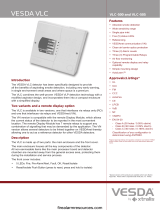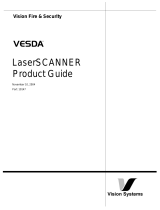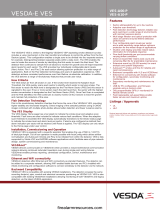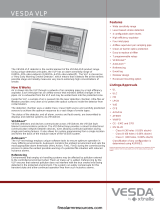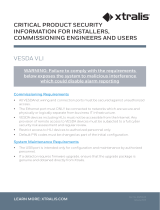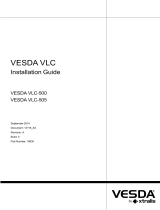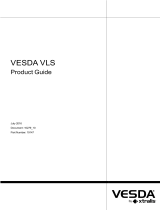Page is loading ...

These installation instructions provide essential information for installing VESDA VLC Aspirating Smoke Detectors in accordance with the system design. Additional installation and
product documentation is listed below in the Reference Documents section.
VESDA VLC-500 and VLC-505 Installation Instructions
System Components
The detector is shipped with the following components:
• 1 aspirating smoke detector
• 1 mounting bracket
• 1 installation instruction sheet
• 1 product guide
Prerequisites
• A completed system design documents
• A 24V DC Power Supply, compliant with local codes and standards
• Screws and inserts that are appropriate for the mounting suface
• RS-232 9-way serial cable for VLC-500, sliding windows HLI (VHX - 0200) for
VLC-505
• Labelsasspeciedinthesystemdesign
• Cable glands that are compliant with the IP rating of the detector
• Conduit,asspeciedinthesystemdesign
• 0.2 mm2 to 2.5 mm2 (24 - 14 AWG) wiring for relays
• APCorlaptopinstalledwithXtralisVSCforinitialconguration
• Standard connection instructions for where the detectors are to be added to a corporate
network
Standards Compliance
UL
Foropenareaprotectiontherealarmthreshold(signal)thatinitiatesanevacuation
procedure via the Fire Alarm Panel must not be set less sensitive than 0.625%/ft. The
detector can send this signal via the Fire Alarm Panel Output signal or the Pre-Alarm
output signal.
Throughvalidationtesting,UnderwritersLaboratoriesInc.hasveriedthatVESDAECO
gasdetectors,wheninstalledwithinthesamplepipenetwork,presentnosignicant
effects on the smoke detection performance of VESDA. The use of the ASPIRE calculation
software is required to verify system design performance with all devices included in the
design.
European Installations
The product must use a power supply conforming to EN54: Part 4.
The product is compliant with EN 54-20 sensitivity requirements provided the following
conditions are met:
• For a Class A detector, hole sensitivity must be better than 1.5% obscuration/m and
transport time less than 60 seconds
• For a Class B detector, hole sensitivity must be better than 4.5% obscuration/m and
transport time less than 90 seconds
• For a Class C detector, hole sensitivity must be better than 10% obscuration/m and
transport time less than 120 seconds
TheselimitsshouldbeveriedusingASPIREduringthedesignofthesamplingpipe
network.
TheproductiscompliantwithEN54-20owmonitoringrequirementsprovidedthe
following conditions are met:
• Theminorlowandminorhighowthresholdsshouldbesetat85%and115%
respectively
• TheowthroughthedetectorpredictedbyASPIREshouldbeintherange20to65
lpm
Power Consumption (18 - 30 VDC Supply)
Power Consumption 5.4 W during normal operation, 5.9 W with alarm on
Environmental Requirements
• Temperature
• Ambient: 0°C to 39°C (32°F to 103°F)
• Sampled Air: -20°C to 60°C (-4°F to 140°F)
• Tested to: -10°C to 55°C (14°F to 131°F)
UL:0°to38°C(32°Fto100°F)
• Humidity: 10-95% RH, non-condensing
Note: Please consult your Xtralis representative for information on operation outside
these parameters or where sampled air is continually above 0.05% obs/m
(0.015% obs/ft) under normal operating conditions.
Reference Documents
Additional installation and product information is contained in the following documents,
which are available for download in the Xtralis partner extranet at www.xtralis.com.
• 10280-VESDAVLCProductGuide
• 10195 - VESDA Commissioning Guide
Installation Instructions
Notes
The VESDA detector can be mounted in an upright
or inverted position. Do not mount the detector with
a sideways orientation.
Ensurethemountingsurfaceisatasthisallowsan
air tight seal to be achieved between the sampling
pipe and the tapered air inlet pipe on the detector.
Refer to the detector Product Guide for information
on inverted mounting.
Ensurethatthereissufcientclearancetomount
the detector, noting the location of air sampling
pipes and cable entry points. Due to the rigid nature
of the plastic pipe, installation must provide for
sufcientmovementinallpipework(airinlet,air
exhaust and cable pipes) to allow pipe ends to be
easilyttedandremoved.
• A: Minimum 50 mm (2 in.) below ceiling level.
• B: The detector can be mounted directly
against a wall or obstruction.
Secure the mounting bracket to the mounting surface
• The mounting bracket for the VESDA VLC is
always mounted in the UP direction. It is clearly
marked with the word “UP” and an upward
pointing arrow.
• Secure the mounting bracket to the surface
using appropriate fasteners, ensuring that the
bracketishorizontallystraightandsitsushon
the surface.
• Determine the ports for cable entry. Press out the
tabs for the cable entry, air inlet and air exhaust
ports.
Install the detector
• VESDA VLC detector.
• Remove the front cover and if necessary
separate it from the enclosure box. The back
of the enclosure box is slotted over the four
mounting bracket tabs. Slide the detector
downwards until it slides onto the tabs.
• Screwintheanti-tamperscrew.Checktoconrm
that the detector does not slide off the mounting
bracket.
Inverted Mounting
Some system designs require that the detector be inverted. Directions for correcting the
orientation of the fascia for an inverted detector are available in the Product Guide
Prepare Detector: Wiring, Pipe Inlet and Exhaust Ports
Remove the appropriate plugs for electrical cable installation (J), air sampling pipe inlet
port (K), and exhaust port (F).
• Ensure that pipes are clean and their ends are square and smooth.
AProgramming socket
15 Pin for VLC-505
9 Pin for VLC-500
B Termination card
C VESDAnet number
DAirltercartridge
EFilter screw
FAir exhaust port
GAspirator
H1.6 Amp fuse
IAnti tamper screw
JCable entry ports
KAir inlet port
LWire terminal strips
• Insert the inlet and exhaust pipes (if used) into the correct inlet ports (K) and
exhaust port (F).
• Feed the electrical wiring connections through the cable entry ports.
• Usethecorrectcableglandsizetotintothe26mm(1”)cableentryport.Use
correctly rated cable glands to maintain the required IP rating.
Note: Do not glue the inlet and exhaust pipe into the detector ports. The product
warranty will be void if the pipes are glued.

Wiring: Power, Relays, GPI, Loop Module, VESDAnet VLC-505
Warning: Always switch detector power OFF before plugging/unplugging electrical, relay
or network connections. Failure to do so may cause data corruption and/or
component failure.
VLC-505
Terminal A Terminal B
1 Bias (-) (GND) 1 Shield
2 Reset (-) (GPI) 2 VESDAnet A (-)
3 Reset (+) (GPI) 3 VESDAnet A (+)
4 Bias (+) 4 Shield
5 LED (-) (GND) 5 VESDAnet B (-)
6 LED (+) 6 VESDAnet B (+)
7 FIRE (NO) 7 Power (-)
8Fire (C) 8Power (+)
9 Pre-Alarm (NO) 9 Power (-)
10 Pre-Alarm (C) 10 Power (+)
11 Fault (NO) NC = Normally Close
NO = Normally Open
C = Common
12 Fault (C)
13 Fault (NC)
Legend
ATerminal A D1.6 Amp Fuse
B Terminal B E VESDAnet Socket
C Relays
The contents of this document are provided on an “as is” basis. No representation or warranty (either express or implied) is made as to the completeness, accuracy or reliability of the contents of this document. The
manufacturerreservestherighttochangedesignsorspecicationswithoutobligationandwithoutfurthernotice.Exceptasotherwiseprovided,allwarranties,expressorimplied,includingwithoutlimitationanyimplied
warrantiesofmerchantabilityandtnessforaparticularpurposeareexpresslyexcluded.
Xtralis, the Xtralis logo, The Sooner You Know, VESDA-E, VESDA, ICAM, ECO, OSID, HeiTel, ADPRO, IntrusionTrace, LoiterTrace, ClientTrace, SmokeTrace, XOa, XOh, iTrace, iCommand, iRespond, iCommission,
iPIR,andFMSTaretrademarksand/orregisteredtrademarksofXtralisand/oritssubsidiariesintheUnitedStatesand/orothercountries.Otherbrandnamesmentionedhereinareforidenticationpurposesonlyand
may be trademarks of their respective holder(s). Your use of this document does not constitute or create a licence or any other right to use the name and/or trademark and/or label.
This document is subject to copyright owned by Xtralis. You agree not to copy, communicate to the public, adapt, distribute, transfer, sell, modify or publish any contents of this document without the express prior written
consent of Xtralis.
www.xtralis.com
UK and Europe +44 1442 242 330 D-A-CH+49431232841The Americas +17817402223
Middle East +96265885622Asia +862152400077 Australia and New Zealand +61 3 9936 7000
Part: 30767
GPI – General Purpose Input
This terminal is used to “Reset + Isolate”, “Mains OK” or “Standby” functions. The input
terminal require a voltage supply between 5V and 24 VDC to operate. The voltage input to
this terminal is isolated from the system by an optocoupler device. Connect the Reset (+)
terminal to the Bias (+) terminal and the Reset (-) terminal to the relay / switch output of the
external device which is connected in series to the Bias (-) terminal.
Refer to the Product Guide for further information.
Connection to Addressable Loop Module for Reporting Alarms and Faults
This wiring example is for wiring VESDA
detectors to a typical third party Input Loop
Module with three inputs.
This is an example drawing. Refer to the
appropriate product manual for the exact
wiring details of the third party equipment.
* EOL = End of Line Resistor
Connection to VESDAnet For VLC-505
A+
A-
B-
Shield
Module
1Module 2Module 3
Module 5Module 4
Shield
B+
A+
A-
B-
Shield
Shield
B+
A+
A-
B-
Shield
Shield
B+
A+
A-
B-
Shield
Shield
B+
A+
A-
B-
Shield
Shield
B+
(VESDA VLC)
The diagram shows an example of the
wiring for a closed VESDAnet loop, which
istherecommendedconguration.Remove
the factory default A and B links from the
VESDAnet prior to connecting the detector
to the VESDAnet. It is recommended that
120 Ohm twisted pair cables (e.g. Belden
9841)beusedforincludingthedevices
in the network, with a maximum length
between devices of 1.2 km The polarity
of the data wires must be maintained
throughout the network.
Communications
• VESDAlink socket VLC-500
• VESDAnet socket for VLC-505
Sampling Pipe Network
Complete the pipe network installation in accordance with the system design. Refer to
the detector Product Guide and the VESDA Pipe Network Installation Guide for general
information regarding pipe network installation.
• Ensure that the exhaust is open, the pipe is clear and all sampling holes have been
drilled
Power Up
Connect 24 VDC power to the Power In terminals
Conguration
Forinitialconguration,useaVESDAlinkorVESDAnetconnectionandtheXtralisVSC
software.
• Performthecongurationstepsmentionedintheproductguideandcommissioning
guide then proceed with the normalization instructions below
• Let the detector run for approximately 2 minutes
• Normalizetheairow.Thistakesapproximately10minutes,afterwhichthepipeow
rates (%) should be close to 100%.
• Reset the detector. It should now be running without faults.
Commissioning
• Carry out a smoke test. Refer to the product guide and commissioning guide for further
information.
Document: 32439_00
VLC-500
Terminal A Terminal B
1 FIRE (NO) 1 Bias (-) (GND)
2 Fire (C) 2 Reset (-) (GPI)
3 Pre-Alarm (NO) 3 Reset (+) (GPI)
4 Pre-Alarm (C) 4 Bias (+)
5 Fault (NO) 5 LED (-) (GND)
6 Fault (C) 6 LED (+)
7 Fault (NC) 7 Power (-)
NC = Normally Close
NO = Normally Open
C = Common
8Power (+)
9 Power (-)
10 Power (+)
Legend
ATerminal A D1.6 Amp Fuse
B Terminal B E VESDlink Socket
C Relays
Note: To remove the pipe inlet and cable entry port plugs, place a large screwdriver in
the large slot and twist, or use a small screwdriver in the side slots to lever the
plug out.
Power and Relay Wiring
Power: There are two sets of power terminals on the main board. Connect a 24 VDC
power supply to the PWR IN If required, connect to another detector via the PWR OUT
Relays: The relays interface to the Fire Alarm Control Panel (FACP) to communicate
faults, alarms and disabled states. Relay contacts are rated 2 A @ 30 VDC, resistive.
Connect as required by the system design. Use electrical wire sizes from 0.2 mm² to
2.5 mm² (24 -14 AWG). Refer to the Addressable Loop Module example.
Warning: Ensure that all wiring complies with manufacturer’s instructions and local and
nationalredetectioncoderequirements.RefertoCodesandStandards
Information for Air Sampling Smoke Detection section of the detector product
guide for further information on wiring compliance.
Caution: DO NOT LOOP WIRE UNDER TERMINALS WHEN WIRING DETECTORS.
BREAK WIRE RUNS TO PROVIDE SYSTEM SUPERVISION OF CONNECTIVITY.
Note: For information on wiring for other types of devices that may be required by
the system design, refer to the detector Product Guide and documentation
accompanying the device.
VESDA VLC-500 and VLC-505 Installation Instructions
/

